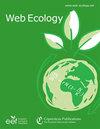入侵性长叶金合欢在葡萄牙的遗传多样性和分化
IF 2.3
3区 环境科学与生态学
Q2 ECOLOGY
引用次数: 11
摘要
摘要金合欢是一种世界性的侵略性入侵者。这个物种是由林业部门带到葡萄牙的,现在遍布全国,具有很强的生态和社会影响。虽然已经进行了一些生态学和生理学的研究,但对该物种的分子研究却很少。特别是,入侵物种的遗传变异评估显然值得更多的关注。本研究旨在评价不同地中海条件下外来入侵长叶橐吾居群的遗传多样性和遗传分化。为此,我们研究了葡萄牙海岸的三个沙丘种群:Osso da Baleia(中地中海),Pinheiro da Cruz和Vila Nova de Milfontes(中地中海)。除后一个案例研究外,所有的金合欢植物样本都位于松林下,我们在与农田边缘相关的多样化栖息地条件下进行了采样。根据历史记录,还可以比较原始种植园和最近入侵地区的金合欢样本。我们使用了两种分子标记-简单序列重复序列(ISSR)和微卫星(SSR)。ISSR分析显示。各采样点长叶属种群多样性水平相近,分化程度较低(ΦPT=0.135)。然而,根据区域(宏观尺度)的采集地点,样本倾向于聚集。微型卫星证实了这种低分化模式。我们的研究结果表明,在先前的研究中观察到的物候和生殖成功的差异不能仅仅用遗传多样性和分化来解释。此外,我们的研究结果与历史资料一起表明,长叶冷杉有一个单一的原始引种和随后的驯化过程。本文章由计算机程序翻译,如有差异,请以英文原文为准。
Genetic diversity and differentiation of invasive Acacia longifolia in Portugal
Abstract. Acacia longifolia is an aggressive invader worldwide. This
species was brought to Portugal by the forestry services and is now
found throughout the country with very strong ecological and social
impacts. Although several ecological and physiological studies have
been carried out, molecular studies in this species are
sparse. Particularly, genetic variability evaluation in invasive
ranges clearly deserves more attention. The aim of this study was to
evaluate the genetic diversity and the genetic differentiation among
populations of the alien invasive A. longifolia under
different Mediterranean conditions. For that we studied three sandy
dune populations along the Portuguese coast: Osso da Baleia
(mesomediterranean), Pinheiro da Cruz and Vila Nova de Milfontes
(termomediterranean). All sampled acacia plants were located
underneath a pine forest, with the exception of the latter case
study, where we also sampled in a diversified habitat conditions
associated with the margins of agriculture fields. According to the
historical records, it was also possible to compare acacia samples
from original plantations and recently invaded areas. We have used
two molecular markers – inter-simple sequence repeats (ISSR) and
microsatellites (SSR). ISSR analysis showed that
A. longifolia populations at all sampled locations have
similar levels of diversity and a relatively low differentiation
( ΦPT=0.135 ). However, samples tended to cluster
according to the regional (macro-scale) collection
site. Microsatellites confirmed this low differentiation
pattern. Our results indicate that differences in phenology and
reproductive success observed during a previous study cannot be
accounted for by genetic diversity and differentiation
alone. Furthermore, our results taken together with historical
information of A. longifolia suggest a single original
introduction and a subsequent acclimation process.
求助全文
通过发布文献求助,成功后即可免费获取论文全文。
去求助
来源期刊

Web Ecology
Agricultural and Biological Sciences-Ecology, Evolution, Behavior and Systematics
CiteScore
4.60
自引率
0.00%
发文量
6
审稿时长
17 weeks
期刊介绍:
Web Ecology (WE) is an open-access journal issued by the European Ecological Federation (EEF) representing the ecological societies within Europe and associated members. Its special value is to serve as a publication forum for national ecological societies that do not maintain their own society journal. Web Ecology publishes papers from all fields of ecology without any geographic restriction. It is a forum to communicate results of experimental, theoretical, and descriptive studies of general interest to an international audience. Original contributions, short communications, and reviews on ecological research on all kinds of organisms and ecosystems are welcome as well as papers that express emerging ideas and concepts with a sound scientific background.
 求助内容:
求助内容: 应助结果提醒方式:
应助结果提醒方式:


